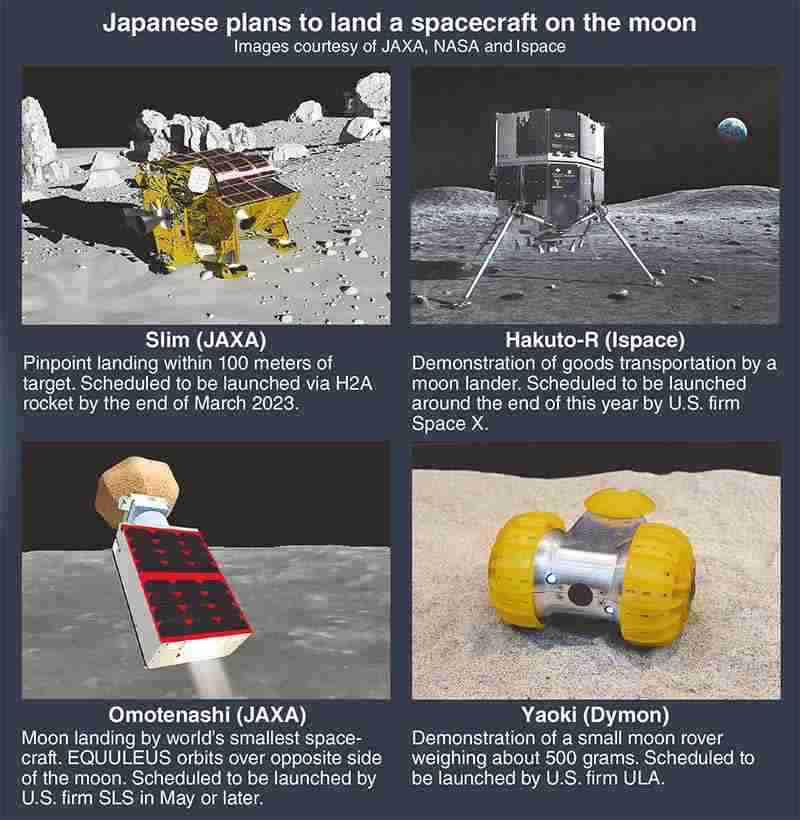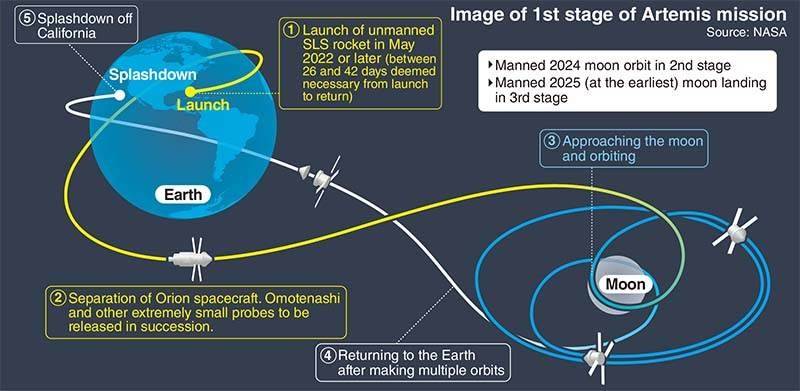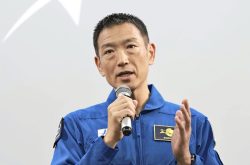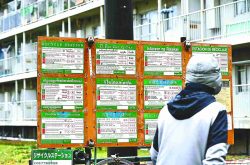
15:02 JST, April 18, 2022
Japan is inching ever-closer to its first moon landing, as research and development moves into top gear from this fiscal year.
The Japan Aerospace Exploration Agency (JAXA) and space-development startups are working to launch unique probes and rovers to the Earth’s solitary natural satellite. Moon-exploration projects are underway overseas, too, and knowledge of our rocky neighbor is set to burgeon in the near future.
Pinpoint landing
Lunar resources are a hot topic among moon researchers. It is thought that water exists around the moon’s north and south poles, opening up access to potential drinking water and fuel use.
Technology that allow probes and other devices to make targeted landings on the moon is essential to Japan’s space-exploration efforts. By the end of March next year, JAXA aims to launch its Slim probe on a H2A rocket and make a pinpoint landing on the moon.
Some other countries’ landings have missed their target by at least several kilometers. Slim probe operators, however, aim to hit a target near the Shioli crater with an error margin of 100 meters or less.
JAXA has long been recognized as a landing specialist. In 2019, the Hayabusa-2 probe landed on the Ryugu asteroid with an error margin of 60 centimeters and succeeded in returning samples to the Earth.
However, asteroids have almost no gravity and it is much more difficult to land on the moon, which has a gravity about one-sixth that of our home planet.
The Slim probe will be sent landing instructions while it orbits the moon at a speed of nearly 2 kilometers per second. It will then reduce speed and make a slow, free-fall landing.
“It’s akin to slamming on the brakes while driving at maximum speed on an expressway and bringing the car to a neat stop in a specific parking space,” said JAXA project manager Shinichiro Sakai.
Small, but effective
Plans are also afoot to send two other probes to the moon. The tiny spacecraft — acronymically named Omotenashi and Equuleus — have been jointly developed by JAXA and the University of Tokyo. Each probe measures 37 centimeters long, 24 centimeters wide and 11 centimeters high.
The probes are scheduled to be launched alongside other small robotic explorers by the United States’ new Space Launch System rockets in and after May.
Omotenashi will be sent to the moon. Its operators say that, if successful, it will be the smallest spacecraft ever to have landed on the lunar surface.
The probe will be traveling at about 50 meters per second when it lands. If it touches down without damage, it will be able to send electronic signals to Earth.
JAXA Prof. Tatsuaki Hashimoto, who is responsible for the project, said, “The success rate is about 60%, but we want to move forward bravely without fear of failure.”
Hashimoto believes landing technologies can be tested and proven cheaply using extremely small probes, encouraging universities and small and midsize companies to start research in basic fields.
Equuleus, meanwhile, will orbit above the opposite side the moon with minimum fuel, while utilizing the gravity of the moon and the sun. In this way, technologies aimed at sustaining long-term orbits can be tested and developed.
Startups get on board
Private-sector startups, too, are sniffing out business opportunities in such realms as lunar resource development and the transportation of goods.
One such firm, Tokyo-based Ispace Inc., is scheduled to launch a moon lander aboard a rocket operated by U.S. space development company Space X, around the end of this year.
As the first step of its project, named Hakuto-R, the company plans to dispatch a moon-landing craft carrying a number of devices, including Sora-Q — an exploration robot jointly developed by JAXA and Tomy Co.
Ispace ultimately aims to provide a high-frequency, low-cost service that transports goods to the moon. “We want to make developmental progress, rather than just doing it once,” said company CEO Takeshi Hakamada.
Another Tokyo-based startup, Dymon Co., has developed an extremely small two-wheeled rover named Yaoki. The rover’s name is based on a Japanese proverb meaning, “If you’ve fallen over seven times, stand up eight times.” The firm says its rover has the ability to right itself in any situation; the doughty craft will be launched in the latter half of this year, at the earliest.
Looking ahead, the company plans to send a large number of even-lighter rovers to the moon, so people on Earth can enjoy lunar “trips” using avatars. Dymon CEO Shinichiro Nakajima said, “I want to realize an age in which everybody can visit the moon using this kind of rover.”
Japan’s space exploration programs are characterized by a wide variety of probes and other devices, but space rocket launches have been often delayed due to development-related issues.
Interest is thus growing over which spacecraft will go down in history as having made Japan’s inaugural moon landing.

"Science & Nature" POPULAR ARTICLE
-

‘Fiercest, Most Damaging Invasive Weed’ Spreading in Rivers, Lakes in Japan, Alligator Weed Found in Numerous Locations
-

Univ. in Japan, Tokyo-Based Startup to Develop Satellite for Disaster Prevention Measures, Bears
-

Japan Set to Participate in EU’s R&D Framework, Aims to Boost Cooperation in Tech, Energy
-

Tsunami Can Travel Vast Distances Before Striking, Warn Japanese Researchers
-

Japan’s H3 Rocket Failed in Latest Launch, Says Official
JN ACCESS RANKING
-

BOJ Gov. Ueda: Highly Likely Mechanism for Rising Wages, Prices Will Be Maintained
-

Core Inflation in Tokyo Slows in December but Stays above BOJ Target
-

Japan Govt Adopts Measures to Curb Mega Solar Power Plant Projects Amid Environmental Concerns
-

Osaka-Kansai Expo’s Economic Impact Estimated at ¥3.6 Trillion, Takes Actual Visitor Numbers into Account
-

Major Japan Firms’ Average Winter Bonus Tops ¥1 Mil.






















